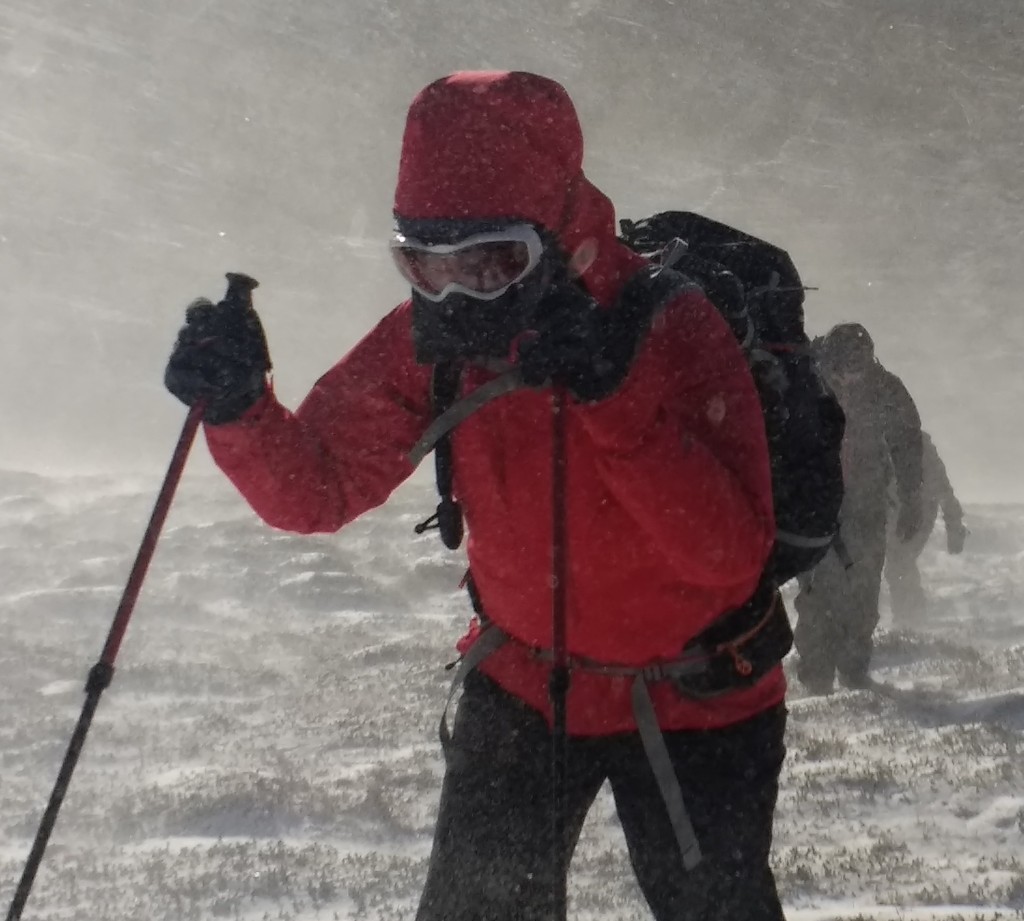There are some essentials you must have to go hillwalking. Food and drink as you like (a hot drink is
very nice on a cold day), and then everything else, called your 'kit'. A lot of this you may already have or can borrow.
It is possible to get all your kit on a
limited budget. It is also possible to spend every spare penny you have, as 'outdoor gear' shops are in every high
street. The problem is that you
need some experience before you know what you need, so it is usually best to borrow or buy just the essentials and then talk to
people once you are on the hill for free unbiased advice.
Boots
A good pair of boots keeps your feet dry, gives you good grip and protects and supports your feet and ankles.
Leather is nice and comfortable, synthetic is cooler and lighter, the price is much the same for a decent pair.
Decathlon sell the Quecha range of good quality 100% waterproof boots starting at less than £50.
Jacket
You need a jacket that is fully waterproof. Getting soaked through is miserable. As ever, you can spend a small fortune on a Gore Tex Pro marvel,
but you can easily get by with much cheaper options. They must have fully taped seams and be guaranteed waterproof.
A second jacket can be handy too, a more breathable one for
when it is not raining. Again, good examples
can be found at Go Outdoors, Decathlon, Blacks and Millets.

Waterproof overtrousers
We put on overtrousers when it rains. Decathlon sell overtrousers for £12, and they work fine,
if perhaps a little clammy, but are good to get started with. More expensive
items have zips and buttons which go all the way from hip to ankle so are quick to put on over your boots.
Layers
Much of the time you will be feeling hot, walking up hills is hard work, and even in winter all you sometimes need is one
layer under your jacket, but at rest, or on top of a windy hill lots of insulating layers are needed under the jacket, so
layers are very important.
Cotton tends to soak up body moisture and get sodden and is a poor choice, but most other materials,
synthetic, wool, etc. work fine
between your body and your jacket. You will almost certainly manage your first walks with what you have already in your wardrobe. Take
several layers rather that one all or nothing thick insulating layer. Fleece
layers are cheap, light, come in different thicknesses, and are quick drying and cosy. Trousers should be loose fitting and not cotton. Jeans
are particularly bad as they
soak up water, are slow to dry and are uncomfortable in these situations.
Backpack
You will need a backpack to hold your clothes, food, water, etc. It will need to have a hip strap so the weight is supported on your
hips and not your shoulders. Again, you can get one for any price, and the main difference is that the more expensive ones will take
more abuse and last longer. Something around 30 litres is fine.
Hat and Gloves
A hat that won't blow away and waterproof gloves. Aldi usually have these things in their 'tat' racks
and they do the job.
Less essential equipment for newcomers
The items above will get you started. These other items are things you could take or purchase later.
Gaitors
These wrap around your lower legs to stop heather and snow getting into the top of you boots.
Survival bag and whistle
The club carries group shelters on each walk, but it is a good idea to carry a large plastic 'survival' bag in the hills.
In an emergency situation, the difference between being inside a large plastic bag, or being exposed to the wind and rain
is enormous. These cost £5 from outdoor shops.
Walking Poles
Many people find walking poles help with balance and security, especially crossing burns and going down steep
rough ground.
Map and Compass
Not getting lost in the hills is important, so navigating is important, however club novices are led by more experienced
walkers so this is something you can learn as time goes on.
Head torch
It does happen, especially in winter, that something delays the group and the last
miles are done in the dark.
Ski Goggles
In windy wintry conditions, with snow blowing around, ski gogggles are pretty much
essential to see anything at all
Ice axe and Crampons
Something for you to discuss with the experienced members. Winter walks are normally selected which do not require crampons
and ice axe, but conditions in Scotland can change quickly and there can often be more snow lying that expected and
forest tracks can be covered in sheet ice. If you take some form of crampon, even the Yak Trax variety, it makes a huge difference.
Ice axes are good for balance and traction in winter conditions.